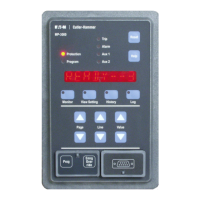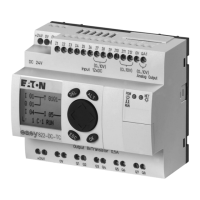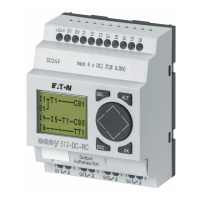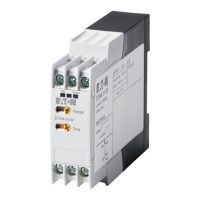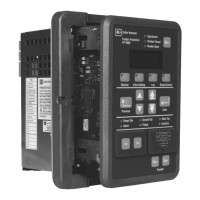Page 6-2
www.eaton.com
IB02602002E
MP-4000
To minimize problems with CT saturation during faults, keep the CT wiring
as short as possible and use very heavy wire. The total resistance of the
connecting wire should not be much larger than the secondary resistance of
the CT itself. The MP-4000 presents a very low burden.
Every phase and ground CT circuit must have one and only one
grounding point. Figures 6.7, 6.8, and 6.9 show the common neutral
connection of the 3-phase CTs, and the ground fault CT, connected at
one point to a non-current-carrying ground. Do not use a neutral or
current carrying conductor for this grounding, because the noise result-
ing from this connection would disrupt MP-4000 measurements.
Residual connection of the phase CT secondaries that form a ground
current signal do not provide a sensitivity approaching that of the ux-
canceling ground CT (refer to Subsection 9.1.10).
6.1.2 PT Wiring
Connect the PTs as shown in Figures 13.4, 13.5 and 13.6. For optimal
performance, the external PTs should be selected such that the volt-
age inputs to the MP-4000 are 120 Vac nominal. The voltage inputs
are clamped at 220 Vac. Continuous voltages above this level should
never be applied to the MP-4000, and may result in failure of the unit.
The voltage inputs to the MP-4000 should be fused.
CAUTION
CONTINUOUS VOLTAGES ABOVE 220 VAC SHOULD NEVER BE
APPLIED TO THE MP-4000; THEY MAY RESULT IN FAILURE OF
THE UNIT. THE VOLTAGE INPUTS TO THE MP-4000 SHOULD BE
FUSED.
FOR PROPER OPERATION OF VOLTAGE MONITORING AND PRO-
TECTION, THE NEUTRAL/GROUND PT INPUT MUST BE SOLIDLY
CONNECTED TO EARTH GROUND.
6.1.3 Output Contact Wiring
Refer to the Technical Specications in Section 3 for ratings of output
contacts, and check them against controlled loads.
Figure 6.7 shows a typical connection of MP-4000 output relay con-
tacts in the motor control circuits. However, the outputs other than the
trip relay are completely programmable, so there can be nearly innite
choice in the connection and use of these outputs for tripping, alarm-
ing, and auxiliary control.
The installation design engineer must study Sections 5 and 9 to
understand the available output functions and programming options.
This engineer must record and conrm the settings, and also design a
consistent connection of the form C contacts of the four output relays
to the motor control system.
Pay attention to these features of the programming and contact use:
Each relay can be set as Mode 1 (normally de-energized;
energized to activate), or Mode 2 (normally energized/de-en-
ergize to activate). Weigh this against the use of NO versus
NC contacts in the control scheme (refer to Subsection
5.12.1).
All trips are steered to the trip relay (terminals 11-12-13)
without choice - connect this to the contactor or trip coil. For
all other relays and functions, the User chooses what func-
tion activates which relay.
It is recommended that the alarm relay be used in Mode 2;
all alarm conditions should be directed to it. Connect the
annunciator to terminals 17 and 18. With this connection, an
alarm is given if the relay or its power supply fails, or when
any other problems the MP-4000 can actively report arise.
However, if the MP-4000 is de-energized routinely in service,
•
•
•
use the alarm relay in Mode 1, and connect the annunciator
to terminals 18 and 19 to avoid nuisance alarms.
If the relay AUX 1 is set for the process load shedding func-
tion, it can not be used for anything else.
If the relay AUX 2 is set for transition control of a reduced-
voltage starter, it can not be used for anything else.
6.1.4 AC Supply Wiring
See Figure 6.10. Connect terminals 4 and 7 to a source of control
power rated at either 120 Vac or 240 Vac. The MP-4000 automati-
cally congures its power supply to work with one or the other value.
Nominal values other than 120 Vac or 240 Vac are not recommended.
However, the MP-4000 can handle depressions, dips, and limited
sustained variations in the normal course of service. Refer to the
Technical Specications in Section 3.
The optional URTD module can operate only from 120 Vac. For a 240
Vac source, use a step-down transformer suitable for a load of
6 VA. Do not attempt to power the URTD from the MP-4000 120 Vac
discrete source. That source is for contact reading only, and cannot
handle the URTD burden.
If the supply is a dc battery system, use the optional IQ DC power
supply (Cat. # IQDCPS). The IQ DC supply can power the MP-4000,
the URTD, if used, and the discrete input circuits of the MP-4000.
The total burden capability of the IQ DC module is 30 VA; the unit can
operate from nominal voltages of 100 Vdc to 150 Vdc.
6.1.5 Discrete Input Contact Wiring
See Figures 6.10 and 6.11. The particular contacts to be connected
depend on the settings programmed in the MP-4000. There is a long
list of functions that can be assigned to each of these inputs.
The engineer who designs the installation should study Sections 5 and
9 to understand and designate the use, if any, of the discrete contact-
sensing inputs. Note that only one use can be assigned to each input.
CAUTION
THE DISCRETE INPUTS SHOULD BE ENERGIZED ONLY FROM
120 VAC. THE MP-4000 TERMINAL 6 IS ALWAYS A SOURCE OF
120 VAC, WHICH CAN BE USED TO WET REMOTE CONTACTS,
EVEN WHEN THE MP-4000 IS POWERED FROM 240 VAC.
The discrete input circuits are totally isolated from the other circuits in
the MP-4000, and have their own common connection, terminal 9. If
the 120 Vac discrete contact-wetting source from terminal 6 is used,
tie the discrete input common terminal 9 to the ac supply neutral termi-
nal 7, as shown in Figure 6.12.
Figure 6.11, lower portion, shows an alternate scheme for using a
remote contact wetting source. The source must be 120 Vac. The
contact signal(s) and the remote neutral must be brought to the MP-
4000 discrete inputs. For noise immunity and safety, do not connect
the discrete common terminal 9 to terminal 7 or any other nearby
neutral if a remote wetting source is in use.
CAUTION
BEWARE OF LARGE SHUNT CAPACITANCE ACROSS CONTACTS
OR IN SOLID-STATE RELAYS CONNECTED TO THE MP-4000 DIS-
CRETE INPUTS. CHARGING CURRENT THROUGH THE CAPACI-
TOR COULD CAUSE A FALSE INDICATION OF A CLOSED CON-
TACT. KEEP TOTAL CAPACITANCE BELOW 0.05 MICROFARADS.
•
•
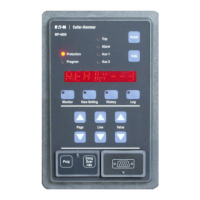
